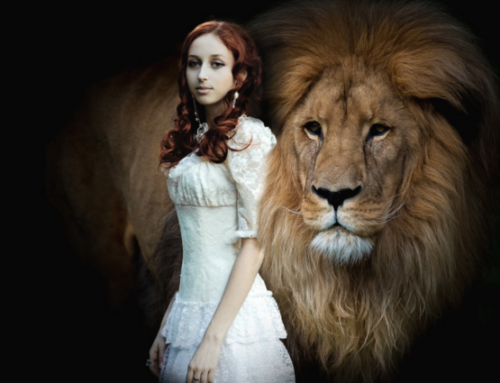“The Black Cat” is a story that collapses in despair over the primal terror of mindless tragedy—which is precisely what makes it a devilishly good read…
 Even as nature falls asleep under the fiery spell of autumn, there awakens in the lords of nature a keen spiritual sensitivity that can be a type of perversity. Fall inspires fallen men with a fascination in tales of terror and supernatural horror, tales that dwell on dark mysteries that transcend the regular course of nature. The celebration of fear is a strange and ancient one, which is the source of its strange and ancient power. It is a power beyond intellect. It is a power stronger than fear itself. “The kind of fear here treated of is purely spiritual,” wrote Charles Lamb in Witches, and Other Night-Fears, “that it is strong in proportion as it is objectless upon earth—that it predominates in the period of sinless infancy—are difficulties, the solution of which might afford some probable insight into our ante-mundane condition, and a peep at least into the shadow-land of pre-existence.” Another poet, however, tells that some witches and night-fears are not purely spiritual, but are moving bodily among us—disguised as black cats.
Even as nature falls asleep under the fiery spell of autumn, there awakens in the lords of nature a keen spiritual sensitivity that can be a type of perversity. Fall inspires fallen men with a fascination in tales of terror and supernatural horror, tales that dwell on dark mysteries that transcend the regular course of nature. The celebration of fear is a strange and ancient one, which is the source of its strange and ancient power. It is a power beyond intellect. It is a power stronger than fear itself. “The kind of fear here treated of is purely spiritual,” wrote Charles Lamb in Witches, and Other Night-Fears, “that it is strong in proportion as it is objectless upon earth—that it predominates in the period of sinless infancy—are difficulties, the solution of which might afford some probable insight into our ante-mundane condition, and a peep at least into the shadow-land of pre-existence.” Another poet, however, tells that some witches and night-fears are not purely spiritual, but are moving bodily among us—disguised as black cats.
Edgar Allan Poe was a man who drank deeply from the cup of fear, and of his many macabre masterpieces, one that stands alone in violent perversity and vivid inexplicability is “The Black Cat.” Though the tale claws at the threshold of a terrible spiritual design, it is remarkable for keeping the fantastic and the phantasmagoric inscrutable, leaving only the insanity of physical impossibility, robbed of rhyme and reason. “The Black Cat” is a story that collapses in despair over the primal terror of mindless tragedy—which is precisely what makes it a devilishly good read.
Edgar Allan Poe’s seductively sinister stories are sadly reflective of his own beleaguered life of forty years. Born in Boston, 1809, Edgar Poe was orphaned less than three years later, and found only desperate unhappiness with the Allans of Richmond, Virginia. His unstable, poverty-stricken, drunken, and tempestuous life is the stuff of legend—as is his perplexing death in Baltimore.
But as an artist, Edgar Allan Poe found profound glory in the shadows. His reputation as the father of the modern short story, even now, stems from a literary device that he called a “single effect” to capture and convey the struggle to see the light of truth and justice that shines at the end of a tunnel of ferocity and fear. This struggle dominates Poe’s tales of mystery and madness because it dominated his own tortured existence. Poe, for all his ugliness, believed in beauty; but he believed that beauty required a battle before it might be beheld. And those battles are not always won. His single effect is singularly palpable in “The Black Cat.” Story, psychology, and setting are wonderfully integrated to form a climactic, cataclysmic experience that leaves an impression of hideous horror that is absolutely particular to Poe in its perverse perfection.
“The Black Cat” is a story that breeds mental malady in a slow-boiling malice; and so is madness often the result of malevolence—especially when it is self-inflicted. It is intoned in the frantic scrawl of a last confession. Sentenced to die on the morrow, a nameless narrator laments that his readers will hold him insane, but he avows his sanity while, at the same time, admitting to the wild nature of the events he must put to pen. A raging alcoholism severed him from law and reality, causing strange fits of furious passion, which culminated one night in his cutting out an eye from his own cat’s face. Despair and disgust over his black act eventually drove him to hang the black cat—the creature that bore and brandished the mark of his weakness and wickedness. The descent continues apace with the gravitation of the grave: fire, omens, guilt, psychosis, a bloody axe, a hidden tomb, and a black cat with a “solitary eye of fire” perched upon the head of an upright corpse “greatly decayed and clotted with gore.”
“The Black Cat” explores the boundary between fantasy and fact, between the irrational and the rational. The fearful plot twists in Poe’s famous story fearlessly challenge expectations based upon common human experience; but they do not explain them away by simply substituting a supernatural cause for a natural cause. Instead, no explanation is offered, which is what makes it terrifying. “The Black Cat” taps into one of the primal and principle sources of human terror—the Unknown. Are the inexplicable events scratched out in the shadow of the gallows the delusions of a freak? Or the decrees of fate? Is the black cat a cat? Or a witch? Is God the Most Merciful or the Most Terrible? The truth hovers between the two with a teasing tantalization that is terrifying, and men, in the spirit of perverseness, savor the suspense.
Philosophy can take no account of pure evil. This is the insoluble sufferance of the human condition: There are sins that offer no rational explanation—that are pure and simply evil—and it is a cross that can be almost too great to bear. Edgar Allan Poe certainly struggled under this burden, even unto mental crucifixion, and his writings are the cry of that curse and condemnation. It is enough to make men mad, and also utterly fascinated. The iniquity that prowls in “The Black Cat” carries itself with a silent, feline omniscience and indifference—those qualities that made cats revered as the strange gods of Egypt. The only recourse to counterbalance the spirit of perverseness is the desperate prayer of the victim-villain of the tale: “May God shield and deliver me from the fangs of the Arch-Fiend!”
Republished with gracious permission from Crisis Magazine (October 2015).
The Imaginative Conservative applies the principle of appreciation to the discussion of culture and politics—we approach dialogue with magnanimity rather than with mere civility. Will you help us remain a refreshing oasis in the increasingly contentious arena of modern discourse? Please consider donating now.







Leave A Comment